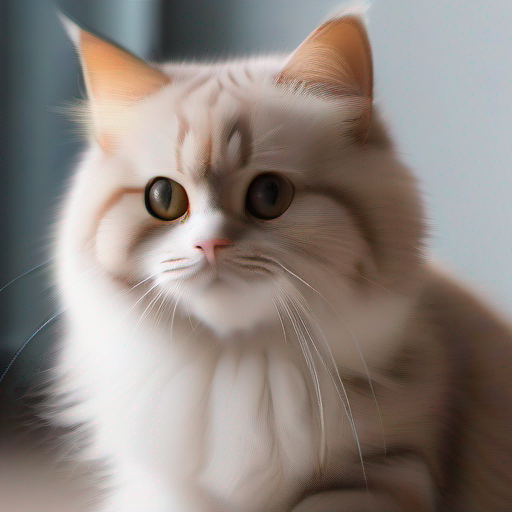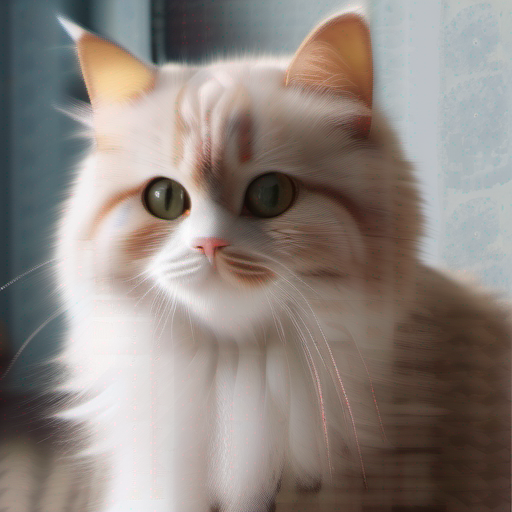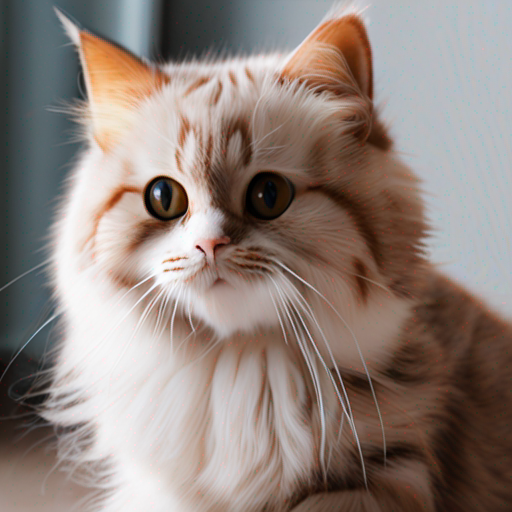Image generation with Stable Diffusion XL and OpenVINO¶
This Jupyter notebook can be launched after a local installation only.
Stable Diffusion XL or SDXL is the latest image generation model that is tailored towards more photorealistic outputs with more detailed imagery and composition compared to previous Stable Diffusion models, including Stable Diffusion 2.1.
With Stable Diffusion XL you can now make more realistic images with improved face generation, produce legible text within images, and create more aesthetically pleasing art using shorter prompts.

pipeline¶
SDXL consists of an ensemble of experts pipeline for latent diffusion: In the first step, the base model is used to generate (noisy) latents, which are then further processed with a refinement model specialized for the final denoising steps. Note that the base model can be used as a standalone module or in a two-stage pipeline as follows: First, the base model is used to generate latents of the desired output size. In the second step, we use a specialized high-resolution model and apply a technique called SDEdit( also known as “image to image”) to the latents generated in the first step, using the same prompt.
Compared to previous versions of Stable Diffusion, SDXL leverages a three times larger UNet backbone: The increase of model parameters is mainly due to more attention blocks and a larger cross-attention context as SDXL uses a second text encoder. The authors design multiple novel conditioning schemes and train SDXL on multiple aspect ratios and also introduce a refinement model that is used to improve the visual fidelity of samples generated by SDXL using a post-hoc image-to-image technique. The testing of SDXL shows drastically improved performance compared to the previous versions of Stable Diffusion and achieves results competitive with those of black-box state-of-the-art image generators.
In this tutorial, we consider how to run the SDXL model using OpenVINO.
We will use a pre-trained model from the Hugging Face Diffusers library. To simplify the user experience, the Hugging Face Optimum Intel library is used to convert the models to OpenVINO™ IR format.
The tutorial consists of the following steps:
Install prerequisites
Download the Stable Diffusion XL Base model from a public source using the OpenVINO integration with Hugging Face Optimum.
Run Text2Image generation pipeline using Stable Diffusion XL base
Run Image2Image generation pipeline using Stable Diffusion XL base
Download and convert the Stable Diffusion XL Refiner model from a public source using the OpenVINO integration with Hugging Face Optimum.
Run 2-stages Stable Diffusion XL pipeline
NOTE: Some demonstrated models can require at least 64GB RAM for conversion and running.
Table of contents:¶
Install prerequisites¶
%pip install -q --extra-index-url https://download.pytorch.org/whl/cpu "diffusers>=0.18.0" "invisible-watermark>=0.2.0" "transformers>=4.33.0" "accelerate" "onnx"
%pip install -q "git+https://github.com/huggingface/optimum-intel.git"
%pip install -q "openvino>=2023.1.0" gradio
SDXL Base model¶
We will start with the base model part, which is responsible for the generation of images of the desired output size. stable-diffusion-xl-base-1.0 is available for downloading via the HuggingFace hub. It already provides a ready-to-use model in OpenVINO format compatible with Optimum Intel.
To load an OpenVINO model and run an inference with OpenVINO Runtime,
you need to replace diffusers StableDiffusionXLPipeline with Optimum
OVStableDiffusionXLPipeline. In case you want to load a PyTorch
model and convert it to the OpenVINO format on the fly, you can set
export=True.
You can save the model on disk using the save_pretrained method.
from pathlib import Path
from optimum.intel.openvino import OVStableDiffusionXLPipeline
import gc
model_id = "stabilityai/stable-diffusion-xl-base-1.0"
model_dir = Path("openvino-sd-xl-base-1.0")
INFO:nncf:NNCF initialized successfully. Supported frameworks detected: torch, tensorflow, onnx, openvino
No CUDA runtime is found, using CUDA_HOME='/usr/local/cuda' 2023-09-19 18:52:15.570335: I tensorflow/core/util/port.cc:110] oneDNN custom operations are on. You may see slightly different numerical results due to floating-point round-off errors from different computation orders. To turn them off, set the environment variable TF_ENABLE_ONEDNN_OPTS=0. 2023-09-19 18:52:15.609718: I tensorflow/core/platform/cpu_feature_guard.cc:182] This TensorFlow binary is optimized to use available CPU instructions in performance-critical operations. To enable the following instructions: AVX2 AVX512F AVX512_VNNI FMA, in other operations, rebuild TensorFlow with the appropriate compiler flags. 2023-09-19 18:52:16.242994: W tensorflow/compiler/tf2tensorrt/utils/py_utils.cc:38] TF-TRT Warning: Could not find TensorRT /home/ea/work/ov_venv/lib/python3.8/site-packages/transformers/deepspeed.py:23: FutureWarning: transformers.deepspeed module is deprecated and will be removed in a future version. Please import deepspeed modules directly from transformers.integrations warnings.warn(
Select inference device SDXL Base model¶
select device from dropdown list for running inference using OpenVINO
import ipywidgets as widgets
import openvino as ov
core = ov.Core()
device = widgets.Dropdown(
options=core.available_devices + ["AUTO"],
value='AUTO',
description='Device:',
disabled=False,
)
device
Dropdown(description='Device:', index=2, options=('CPU', 'GPU', 'AUTO'), value='AUTO')
if not model_dir.exists():
text2image_pipe = OVStableDiffusionXLPipeline.from_pretrained(model_id, compile=False, device=device.value)
text2image_pipe.half()
text2image_pipe.save_pretrained(model_dir)
text2image_pipe.compile()
else:
text2image_pipe = OVStableDiffusionXLPipeline.from_pretrained(model_dir, device=device.value)
Compiling the vae_decoder...
Compiling the unet...
Compiling the text_encoder...
Compiling the vae_encoder...
Compiling the text_encoder_2...
Run Text2Image generation pipeline¶
Now, we can run the model for the generation of images using text
prompts. To speed up evaluation and reduce the required memory we
decrease num_inference_steps and image size (using height and
width). You can modify them to suit your needs and depend on the
target hardware. We also specified a generator parameter based on a
numpy random state with a specific seed for results reproducibility.
import numpy as np
prompt = "cute cat 4k, high-res, masterpiece, best quality, soft lighting, dynamic angle"
image = text2image_pipe(prompt, num_inference_steps=15, height=512, width=512, generator=np.random.RandomState(314)).images[0]
image.save("cat.png")
image
/home/ea/work/ov_venv/lib/python3.8/site-packages/optimum/intel/openvino/modeling_diffusion.py:559: FutureWarning: shared_memory is deprecated and will be removed in 2024.0. Value of shared_memory is going to override share_inputs value. Please use only share_inputs explicitly. outputs = self.request(inputs, shared_memory=True)
0%| | 0/15 [00:00<?, ?it/s]
/home/ea/work/ov_venv/lib/python3.8/site-packages/optimum/intel/openvino/modeling_diffusion.py:590: FutureWarning: shared_memory is deprecated and will be removed in 2024.0. Value of shared_memory is going to override share_inputs value. Please use only share_inputs explicitly. outputs = self.request(inputs, shared_memory=True) /home/ea/work/ov_venv/lib/python3.8/site-packages/optimum/intel/openvino/modeling_diffusion.py:606: FutureWarning: shared_memory is deprecated and will be removed in 2024.0. Value of shared_memory is going to override share_inputs value. Please use only share_inputs explicitly. outputs = self.request(inputs, shared_memory=True)

Text2image Generation Interactive Demo¶
import gradio as gr
if text2image_pipe is None:
text2image_pipe = OVStableDiffusionXLPipeline.from_pretrained(model_dir, device=device.value)
prompt = "cute cat 4k, high-res, masterpiece, best quality, soft lighting, dynamic angle"
def generate_from_text(text, seed, num_steps):
result = text2image_pipe(text, num_inference_steps=num_steps, generator=np.random.RandomState(seed), height=512, width=512).images[0]
return result
with gr.Blocks() as demo:
with gr.Column():
positive_input = gr.Textbox(label="Text prompt")
with gr.Row():
seed_input = gr.Number(precision=0, label="Seed", value=42, minimum=0)
steps_input = gr.Slider(label="Steps", value=10)
btn = gr.Button()
out = gr.Image(label="Result", type="pil", width=512)
btn.click(generate_from_text, [positive_input, seed_input, steps_input], out)
gr.Examples([
[prompt, 999, 20],
["underwater world coral reef, colorful jellyfish, 35mm, cinematic lighting, shallow depth of field, ultra quality, masterpiece, realistic", 89, 20],
["a photo realistic happy white poodle dog playing in the grass, extremely detailed, high res, 8k, masterpiece, dynamic angle", 1569, 15],
["Astronaut on Mars watching sunset, best quality, cinematic effects,", 65245, 12],
["Black and white street photography of a rainy night in New York, reflections on wet pavement", 48199, 10]
], [positive_input, seed_input, steps_input])
# if you are launching remotely, specify server_name and server_port
# demo.launch(server_name='your server name', server_port='server port in int')
# Read more in the docs: https://gradio.app/docs/
# if you want create public link for sharing demo, please add share=True
demo.launch()
Running on local URL: http://127.0.0.1:7860 To create a public link, set share=True in launch().
demo.close()
text2image_pipe = None
gc.collect();
Closing server running on port: 7860
Run Image2Image generation pipeline¶
We can reuse the already converted model for running the Image2Image
generation pipeline. For that, we should replace
OVStableDiffusionXLPipeline with
OVStableDiffusionXLImage2ImagePipeline.
Select inference device SDXL Refiner model¶
select device from dropdown list for running inference using OpenVINO
device
Dropdown(description='Device:', index=2, options=('CPU', 'GPU', 'AUTO'), value='AUTO')
from optimum.intel import OVStableDiffusionXLImg2ImgPipeline
image2image_pipe = OVStableDiffusionXLImg2ImgPipeline.from_pretrained(model_dir, device=device.value)
Compiling the vae_decoder...
Compiling the unet...
Compiling the text_encoder_2...
Compiling the vae_encoder...
Compiling the text_encoder...
photo_prompt = "professional photo of a cat, extremely detailed, hyper realistic, best quality, full hd"
photo_image = image2image_pipe(photo_prompt, image=image, num_inference_steps=25, generator=np.random.RandomState(356)).images[0]
photo_image.save("photo_cat.png")
photo_image
/home/ea/work/ov_venv/lib/python3.8/site-packages/optimum/intel/openvino/modeling_diffusion.py:559: FutureWarning: shared_memory is deprecated and will be removed in 2024.0. Value of shared_memory is going to override share_inputs value. Please use only share_inputs explicitly. outputs = self.request(inputs, shared_memory=True) /home/ea/work/ov_venv/lib/python3.8/site-packages/optimum/intel/openvino/modeling_diffusion.py:622: FutureWarning: shared_memory is deprecated and will be removed in 2024.0. Value of shared_memory is going to override share_inputs value. Please use only share_inputs explicitly. outputs = self.request(inputs, shared_memory=True)
0%| | 0/7 [00:00<?, ?it/s]
/home/ea/work/ov_venv/lib/python3.8/site-packages/optimum/intel/openvino/modeling_diffusion.py:590: FutureWarning: shared_memory is deprecated and will be removed in 2024.0. Value of shared_memory is going to override share_inputs value. Please use only share_inputs explicitly. outputs = self.request(inputs, shared_memory=True) /home/ea/work/ov_venv/lib/python3.8/site-packages/optimum/intel/openvino/modeling_diffusion.py:606: FutureWarning: shared_memory is deprecated and will be removed in 2024.0. Value of shared_memory is going to override share_inputs value. Please use only share_inputs explicitly. outputs = self.request(inputs, shared_memory=True)

import gradio as gr
from diffusers.utils import load_image
import numpy as np
load_image(
"https://huggingface.co/datasets/optimum/documentation-images/resolve/main/intel/openvino/sd_xl/castle_friedrich.png"
).resize((512, 512)).save("castle_friedrich.png")
if image2image_pipe is None:
image2image_pipe = OVStableDiffusionXLImg2ImgPipeline.from_pretrained(model_dir)
def generate_from_image(text, image, seed, num_steps):
result = image2image_pipe(text, image=image, num_inference_steps=num_steps, generator=np.random.RandomState(seed)).images[0]
return result
with gr.Blocks() as demo:
with gr.Column():
positive_input = gr.Textbox(label="Text prompt")
with gr.Row():
seed_input = gr.Number(precision=0, label="Seed", value=42, minimum=0)
steps_input = gr.Slider(label="Steps", value=10)
btn = gr.Button()
with gr.Row():
i2i_input = gr.Image(label="Input image", type="pil")
out = gr.Image(label="Result", type="pil", width=512)
btn.click(generate_from_image, [positive_input, i2i_input, seed_input, steps_input], out)
gr.Examples([
["amazing landscape from legends", "castle_friedrich.png", 971, 60],
["Masterpiece of watercolor painting in Van Gogh style", "cat.png", 37890, 40]
], [positive_input, i2i_input, seed_input, steps_input])
# if you are launching remotely, specify server_name and server_port
# demo.launch(server_name='your server name', server_port='server port in int')
# Read more in the docs: https://gradio.app/docs/
# if you want create public link for sharing demo, please add share=True
demo.launch()
Running on local URL: http://127.0.0.1:7860 To create a public link, set share=True in launch().
demo.close()
del image2image_pipe
gc.collect()
Closing server running on port: 7860
280
SDXL Refiner model¶
As we discussed above, Stable Diffusion XL can be used in a 2-stages approach: first, the base model is used to generate latents of the desired output size. In the second step, we use a specialized high-resolution model for the refinement of latents generated in the first step, using the same prompt. The Stable Diffusion XL Refiner model is designed to transform regular images into stunning masterpieces with the help of user-specified prompt text. It can be used to improve the quality of image generation after the Stable Diffusion XL Base. The refiner model accepts latents produced by the SDXL base model and text prompt for improving generated image.
from optimum.intel import OVStableDiffusionXLImg2ImgPipeline, OVStableDiffusionXLPipeline
from pathlib import Path
refiner_model_id = "stabilityai/stable-diffusion-xl-refiner-1.0"
refiner_model_dir = Path("openvino-sd-xl-refiner-1.0")
if not refiner_model_dir.exists():
refiner = OVStableDiffusionXLImg2ImgPipeline.from_pretrained(refiner_model_id, export=True, compile=False)
refiner.half()
refiner.save_pretrained(refiner_model_dir)
del refiner
gc.collect()
Select inference device¶
select device from dropdown list for running inference using OpenVINO
device
Dropdown(description='Device:', index=2, options=('CPU', 'GPU', 'AUTO'), value='AUTO')
Run Text2Image generation with Refinement¶
import numpy as np
import gc
model_dir = Path("openvino-sd-xl-base-1.0")
base = OVStableDiffusionXLPipeline.from_pretrained(model_dir, device=device.value)
prompt = "cute cat 4k, high-res, masterpiece, best quality, soft lighting, dynamic angle"
latents = base(prompt, num_inference_steps=15, height=512, width=512, generator=np.random.RandomState(314), output_type="latent").images[0]
del base
gc.collect()
Compiling the vae_decoder... Compiling the unet... Compiling the text_encoder_2... Compiling the text_encoder... Compiling the vae_encoder... /home/ea/work/ov_venv/lib/python3.8/site-packages/optimum/intel/openvino/modeling_diffusion.py:559: FutureWarning: shared_memory is deprecated and will be removed in 2024.0. Value of shared_memory is going to override share_inputs value. Please use only share_inputs explicitly. outputs = self.request(inputs, shared_memory=True)
0%| | 0/15 [00:00<?, ?it/s]
/home/ea/work/ov_venv/lib/python3.8/site-packages/optimum/intel/openvino/modeling_diffusion.py:590: FutureWarning: shared_memory is deprecated and will be removed in 2024.0. Value of shared_memory is going to override share_inputs value. Please use only share_inputs explicitly. outputs = self.request(inputs, shared_memory=True)
240
refiner = OVStableDiffusionXLImg2ImgPipeline.from_pretrained(refiner_model_dir, device=device.value)
Compiling the vae_decoder...
Compiling the unet...
Compiling the text_encoder_2...
Compiling the vae_encoder...
image = refiner(prompt=prompt, image=np.transpose(latents[None, :], (0, 2, 3, 1)), num_inference_steps=15, generator=np.random.RandomState(314)).images[0]
image.save("cat_refined.png")
image
0%| | 0/4 [00:00<?, ?it/s]
/home/ea/work/ov_venv/lib/python3.8/site-packages/optimum/intel/openvino/modeling_diffusion.py:606: FutureWarning: shared_memory is deprecated and will be removed in 2024.0. Value of shared_memory is going to override share_inputs value. Please use only share_inputs explicitly. outputs = self.request(inputs, shared_memory=True)
